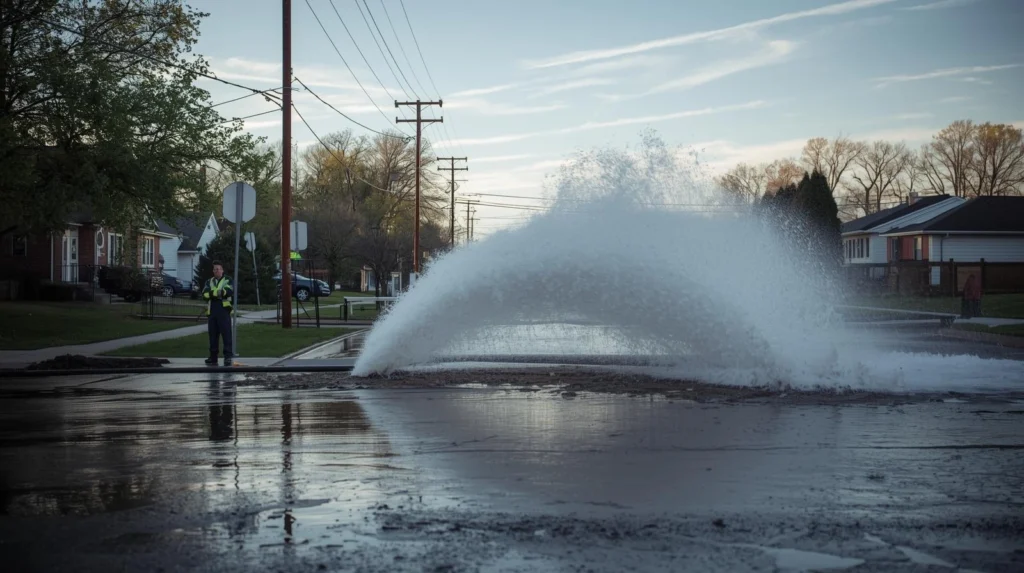Residents across Spalding faced major disruption after two significant water main bursts left thousands of people without water or with severely reduced pressure. The failure, which occurred early in the day, spread across multiple neighbourhoods and affected homes, schools, and various businesses, leading to widespread inconvenience and operational delays.
What Triggered the Water Outage?
The disruption began when a water main on Pennygate failed, causing an immediate drop in supply across the surrounding areas. Shortly after, a second burst was discovered at the junction of Balmoral Avenue and Queens Road, compounding the issue. With two mains compromised simultaneously, pressure levels fell dramatically and left entire streets without running water.
Repair teams were quickly deployed to locate the exact failure points, isolate the damaged sections, and begin emergency works. According to the utility company responsible for the network, both bursts required extensive excavation and inspection before replacement activities could begin. Crews used specialist equipment to identify weaknesses in the network and reroute water where possible to stabilise supply.
Extent of the Impact on Local Residents
The outage affected thousands of households across Spalding, with many reporting dry taps or intermittent flow. Early in the day, several families struggled with basic routines such as preparing meals, maintaining hygiene, or getting children ready for school.
To support residents, the water company began distributing bottled water across multiple points in the region. Supplies were prioritised for households with vulnerable individuals, including elderly residents, infants, and people with medical needs.
Some streets regained partial service by mid-morning, but pressure remained unstable in certain areas due to the ongoing repair work and the difficulty of rerouting supply around two damaged mains.
Schools and Businesses Forced to Adjust
Multiple schools across Spalding reported disrupted morning operations. Without reliable access to water, some faced challenges maintaining hygiene standards and running essential facilities. A few schools kept students in specific sections of buildings where limited water pressure was still available; others prepared for the possibility of early dismissal if conditions worsened.
Local businesses, including restaurants, cafés, and service centres, also experienced complications. Food-related establishments were especially impacted since water is necessary for cleaning, cooking, and maintaining sanitary conditions. Some hotels and guesthouses dealt with guest complaints, while personal care businesses such as salons were forced to postpone appointments.
Industrial and commercial facilities that rely heavily on water for processing or cleaning had to halt certain activities until temporary supply improvements were made.
Efforts by Repair Teams and Timeline for Restoration
Repair operations continued throughout the day as engineers worked to expose the damaged mains. In cases like these, the excavation process alone can be time-consuming, especially when pipes are located beneath busy roads or in areas with other underground utilities.
Teams first isolated the damaged sections on Pennygate to prevent further leakage and to reduce soil erosion around the burst. After stabilising this area, attention shifted to the second major break on Balmoral Avenue and Queens Road. Once excavation teams cleared access, engineers inspected the pipe surfaces, joints, and surrounding soil conditions to identify the cause of the rupture.
Temporary measures were put in place to restore partial flow where possible, but full restoration required completion of both repairs. The water company informed residents that pressure might fluctuate as crews carried out tests and flushed sections of the pipeline to remove debris and air pockets.
Warnings for Continued Low Pressure and Discoloured Water
While significant progress was made by evening, the utility provider warned residents to expect lingering low pressure in certain areas. Homes located at higher elevations or at the end of the network lines were particularly prone to reduced flow.
Customers were also advised that once the system stabilises, some taps may release discoloured or cloudy water. This typically happens when sediment is disturbed during repairs or when pressure is restored suddenly after an outage. The water company emphasised that such discolouration is usually harmless and can be cleared by running taps for a short period.
Residents were further encouraged to avoid using washing machines or dishwashers immediately after restoration until water clarity returned to normal.
High-Quality Pipes & Fittings – Built to Last
Support for Affected Residents and Vulnerable Groups
The provider made arrangements to supply bottled water to vulnerable customers through local distribution teams. Volunteers and local organisations assisted with delivering supplies to elderly individuals, families with infants, and those living with health conditions who rely on uninterrupted water access.
Additional water stations were set up in key areas for residents who needed emergency supplies, and people were encouraged to bring their own containers where possible.
Community Response and Local Updates
Throughout the day, residents shared updates within neighbourhood groups, helping one another stay informed about repair progress and supply distribution points. Local businesses collaborated to support those affected, with some cafés offering free refills using their limited stored water and several shops donating bottled water to nearby homes.
Despite the challenges, the community response remained supportive and coordinated, demonstrating strong local resilience.
Looking Ahead: Preventing Future Disruptions
Incidents involving dual pipeline failures are rare but highlight the importance of regular maintenance and timely upgrades to ageing water infrastructure. The provider stated that a review will be conducted to assess the condition of pipes in the affected areas and determine whether long-term improvements are necessary.
Preventative measures such as enhanced monitoring systems, pressure-regulating equipment, and targeted pipeline replacement programs may be recommended to reduce the risk of similar disruptions in the future.
Conclusion
The double water main failure in Spalding created a significant challenge for local communities, impacting thousands of households, multiple schools, and numerous businesses. Thanks to rapid response efforts, temporary water supplies, and active community cooperation, the situation was gradually stabilised as repair work progressed.
Restoration efforts continued into the evening, with officials assuring residents that full service would return once both mains were securely repaired and system pressure normalised. The incident serves as a reminder of the essential role water infrastructure plays in daily life and the need for continued investment to ensure reliability for the future.


